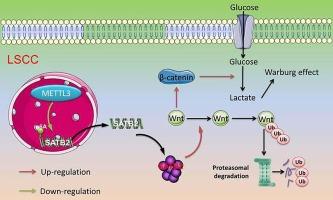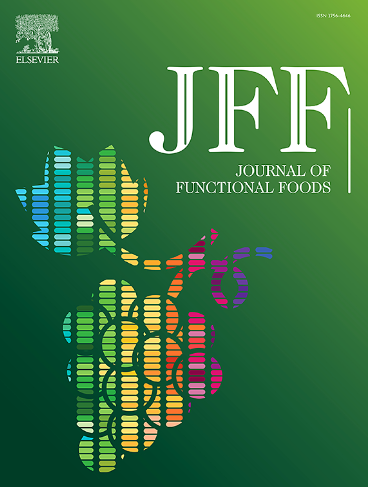The m6A/METTL3 modifies SATB2 suppresses cell proliferation and migration of laryngeal squamous cell carcinoma through targeting the Warburg effect by inhibition of the Wnt/β-catenin pathway
IF 3.8
2区 农林科学
Q2 FOOD SCIENCE & TECHNOLOGY
引用次数: 0
Abstract
This study aimed to explore the specific AT-rich sequence-binding protein 2 (SATB2) regulated Warburg effect of laryngeal squamous cell carcinoma (LSCC) and its possible mechanism of action.
Bioinformatic and single-cell analyses revealed that SATB2 expression was suppressed in patients with LSCC. In an in vitro model, SATB2 suppressed LSCC cells proliferation and migration. Si-SATB2 promotes LSCC cells proliferation and migration. Additionally, sh-SATB2 promotes LSCC proliferation in a mouse model. SATB2 suppresses Wnt expression in an in vitro model and si-SATB2 induces Wnt expression in an in vitro model. Additionally, sh-SATB2 suppresses Wnt expression in a mouse model. Wnt inhibitors reduce the effects of si-SATB2 or sh-SATB2 on the Warburg effect and cell proliferation in a mouse or in vitro model of LSCC. SATB2 interacts with Wnt proteins to reduce Wnt protein ubiquitination. Methyltransferase-like 3 (METTL3)-mediated m6A modification decreases SATB2 stability in a YTH N6-methyladenosine RNA binding protein 1 (YTHDF1) −dependent manner in an LSCC model.
The interaction between the active constituents of SATB2 and Wnt1 results in the inhibition of Wnt/β-catenin, thereby affecting the Wnt/β-catenin-mediated Warburg effect. This study demonstrated that METTL3-mediated m6A modification reduces SATB2 stability in a YTHDF1-dependent manner in an LSCC model, with remarkable efficacy in inducing the Warburg effect in an LSCC model.

m6A/METTL3修饰SATB2通过抑制Wnt/β-catenin通路靶向沃伯格效应,抑制喉鳞状细胞癌的细胞增殖和迁移
本研究旨在探讨特异性富AT序列结合蛋白2(SATB2)调控喉鳞状细胞癌(LSCC)的沃伯格效应及其可能的作用机制。生物信息学和单细胞分析表明,SATB2在LSCC患者中的表达受到抑制。在体外模型中,SATB2抑制了LSCC细胞的增殖和迁移。Si-SATB2能促进LSCC细胞的增殖和迁移。此外,在小鼠模型中,sh-SATB2 可促进 LSCC 增殖。SATB2 在体外模型中抑制 Wnt 的表达,而 si-SATB2 在体外模型中诱导 Wnt 的表达。此外,sh-SATB2 还能抑制小鼠模型中 Wnt 的表达。在 LSCC 的小鼠或体外模型中,Wnt 抑制剂会降低 si-SATB2 或 sh-SATB2 对沃伯格效应和细胞增殖的影响。SATB2 与 Wnt 蛋白相互作用以减少 Wnt 蛋白的泛素化。在LSCC模型中,甲基转移酶样3(METTL3)介导的m6A修饰以YTH N6-甲基腺苷RNA结合蛋白1(YTHDF1)依赖的方式降低了SATB2的稳定性。SATB2的活性成分与Wnt1之间的相互作用导致了对Wnt/β-catenin的抑制,从而影响了Wnt/β-catenin介导的沃伯格效应。本研究表明,在 LSCC 模型中,METTL3 介导的 m6A 修饰以 YTHDF1 依赖性方式降低了 SATB2 的稳定性,在诱导 LSCC 模型中的沃伯格效应方面效果显著。
本文章由计算机程序翻译,如有差异,请以英文原文为准。
求助全文
约1分钟内获得全文
求助全文
来源期刊

Journal of Functional Foods
FOOD SCIENCE & TECHNOLOGY-
CiteScore
9.60
自引率
1.80%
发文量
428
审稿时长
76 days
期刊介绍:
Journal of Functional Foods continues with the same aims and scope, editorial team, submission system and rigorous peer review. We give authors the possibility to publish their top-quality papers in a well-established leading journal in the food and nutrition fields. The Journal will keep its rigorous criteria to screen high impact research addressing relevant scientific topics and performed by sound methodologies.
The Journal of Functional Foods aims to bring together the results of fundamental and applied research into healthy foods and biologically active food ingredients.
The Journal is centered in the specific area at the boundaries among food technology, nutrition and health welcoming papers having a good interdisciplinary approach. The Journal will cover the fields of plant bioactives; dietary fibre, probiotics; functional lipids; bioactive peptides; vitamins, minerals and botanicals and other dietary supplements. Nutritional and technological aspects related to the development of functional foods and beverages are of core interest to the journal. Experimental works dealing with food digestion, bioavailability of food bioactives and on the mechanisms by which foods and their components are able to modulate physiological parameters connected with disease prevention are of particular interest as well as those dealing with personalized nutrition and nutritional needs in pathological subjects.
 求助内容:
求助内容: 应助结果提醒方式:
应助结果提醒方式:


